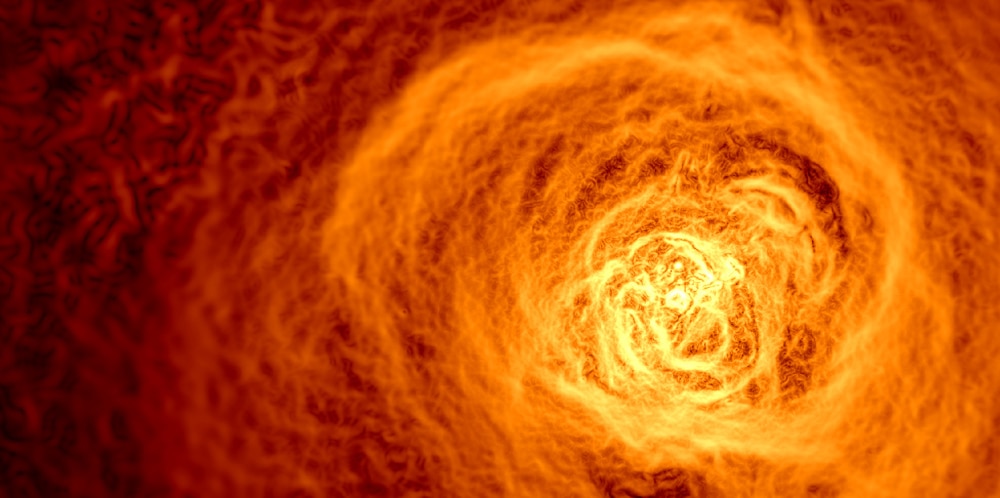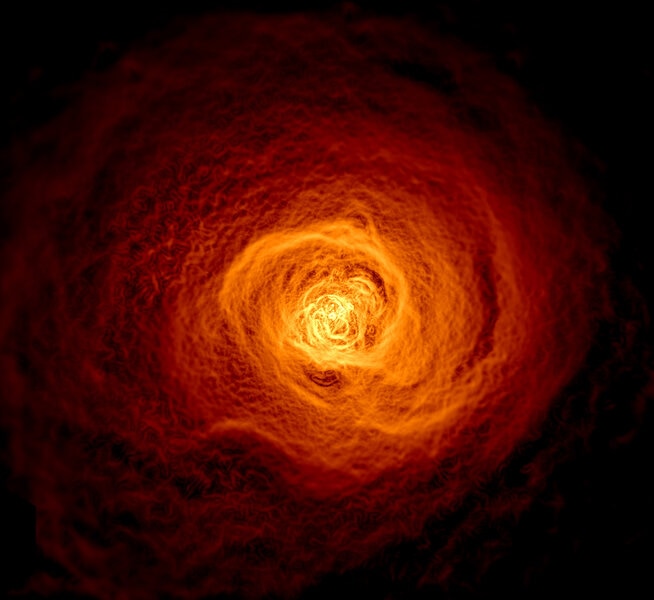Create a free profile to get unlimited access to exclusive videos, sweepstakes, and more!
Colliding clusters of galaxies make waves ... gorgeous, gorgeous waves

Space — and stop me if you’ve heard this before — is pretty big. In general, distances between objects are huge, which means collisions between objects are rare.
Usually. Sometimes, objects, themselves, are pretty big, so the space between them isn’t quite the yawning gulf it is on human scales. For example, while galaxies can be millions of light years apart, the galaxies, themselves, can be hundreds of thousands of light years in size, so collisions can and do happen.
You might think that’s the biggest train wreck the Universe can provide. But, in fact, much more colossal collisions occur, too: When clusters of galaxies collide.
Galaxy clusters are like cities of galaxies, with hundreds, or even thousands, of galaxies in them. Like star clusters, galaxy clusters are held together by their own gravity, with the galaxies orbiting the center of mass. And they’re huge; millions of light years across.
Take the Perseus cluster. It’s 240 million light years away from us, nearly 12 million light years across, and has well over a thousand galaxies in it. When you look at a picture of it in visible light, it appears pretty much as advertised: a collection of lots of galaxies. But when you look at its emission in X-rays — a very high-energy form of light — the picture is literally very, very different. It’s also stunning.
Did I say “stunning”? I meant “holy frak that’s mind-destroyingly cool!”
So, what are you seeing?
That’s an observation of the Perseus cluster taken by the orbiting Chandra X-ray Observatory, and represents a staggering 389 total hours (more than two weeks!) of observations. While the galaxies, themselves, do emit X-rays (from sources like exploding stars, black holes, and the like) the vast majority of X-rays from the cluster come from hot gas between the member galaxies.
Many clusters have hot gas in them. The gas is heated through a variety of mechanisms; for example, it gets stirred up as galaxies ram through it, or by fierce radiation pouring out of some galaxy cores, or when two clusters collide. That last one is important! The collision speeds can be very high, like many thousands of kilometers per second. That’s a small fraction of the speed of light, so when the gas from the two clusters hit each other, fireworks are inevitable.
The Chandra observation of Perseus shows the gas in the cluster, heated to millions of degrees. The image has been specially processed to bring out edge effects; that is, where there are sharp density variations in the gas. Two features are obvious to my eye: The grand spiral pattern swirling out from the center, and the gigantic concave “bay” feature located halfway to the lower left corner from the cluster center.
The swirl is almost certainly due to a collision with another cluster long ago. If the collision were off-center, then the gas would pick up some torque, creating angular momentum, which in turn can create a spiral wave. This can be seen in a killer animation that uses actual physics to model the gas collision between two galaxy clusters:
It shows what happens when a smaller cluster slams into a larger one like Perseus: the gas heats up, and an expanding spiral wave emanates from the center, taking about 2.5 billion years to sweep outward by 500,000 light years. Given the similarity, this is almost certainly what happened in Perseus.
But what about that “bay”? It’s weird. It may look small, but it’s actually 200,000 light years in size, twice the length of our entire Milky Way galaxy! It’s seen in other clusters, too.
It was first thought these might be cavities, or huge bubbles in the gas blown by the supermassive black holes in the centers of what are called active galaxies. As the hot gas in the cluster sweeps past them, it flows around them like water around a sandbar.
But new research shows the bays don’t behave as they should for such an event. Instead, the authors propose that they are actually...cold fronts! Well, kinda.
The gas on the side of the bay closer to the galaxy cluster center is cooler than the gas just on the other side —30 million degrees Celsius as opposed to 150 million! — which is not what you would expect for gas slamming into a bubble formed by an active galaxy. But if the gas is cooler toward the center, then the physics of gas flow means the shape of the bay should be convex, not concave!
So, to explain this, the authors turn to something near and dear to me: Kelvin Helmholtz waves. These are disturbances created when a fluid flows past another fluid. Air flow in Earth’s atmosphere do this, and if clouds form there you can see weird, wave-like patterns forming what look like a kid’s drawing of breaking ocean waves. They’re very cool: I’ve seen them myself a few times in Colorado, and they can be quite arresting.
In this cosmic case, the waves are somewhat bigger...like, a septillion (1018) times bigger! As the gas between galaxies sloshes around after a collision, some of the gas flows past slower moving gas, creating the Kelvin-Helmholtz structures. Because the gas is moving in a spiral wave pattern, the structure looks like a curl in the wave, or a dip. That’s what creates the bay structure. You can see them forming in the animation above, too; the spiral wave isn’t smooth, but has wiggles in it as it slides past the gas outside it. The dip faces the right way, too (that is, it’s concave) as the observations suggest, strengthening the case that this is what’s going on here.
As jaw-dropping as the Chandra image is (and that simulation, too), this is what crushes my brain: A phenomenon I have seen myself here on Earth is replicated on a far, far grander scale a quarter billion light years from our planet! The physics that commands the motion of fluids works whether those are atmospheric layers a few kilometers across, or an expanding wave of gas hundreds of thousands of light years across surfing the space between galaxies.
Science! What works here works elsewhere. Works everywhere. We are one moving part in a Universe filled with them, all ticking away together in the machinery of the cosmos. A higher elegance than that, I cannot conceive.
















